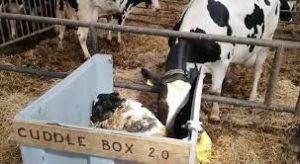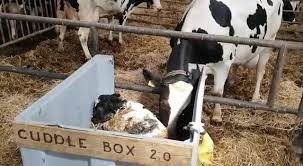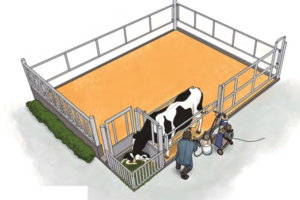Reducing Stress in Cows at Calving
Improving cow comfort and reducing cow stress is now seen as a given route to improving production as well as animal welfare. One of the most stressful times for the cow, and potentially the farmer, is around calving.
Space
A cow in late pregnancy will be a larger animal than the rest of the herd. Therefore, close-up cows that are housed in cubicles should have a cubicle width of 130cm, based on Holstein-Friesians at 650kg mature body. Trough space should be at least 76cm per cow, again, based on Holstein-Friesians.
Lying time is critical at this stage. The release of the hormone relaxin can cause a slight sinking of the pedal bone. Along with increased body weight, this can increase pressure on the sole corium. This may lead to foot problems before the lactation has begun if cows are unable to lie for long enough, ideally, at least 12 hours a day.
Straw bedded yards are a very common dry cow housing solution, especially for close-up cows. A general rule of thumb for these is to provide a lying area of 1.25m2 per 1000 litres of production. Hygiene is important. Many lactational udder problems can be traced back to the dry period. Bedding should be daily and mucking out should be at least every three weeks.
The ideal calving box
In an ideal situation, when calving is near, the cow will separate herself from the rest of the group and nest in a sheltered area. Moving the cow to a calving box may add an extra stress to the cow which could delay labour.
Purpose built dry cow accommodation often includes calving boxes next to the close-up group. This can allow for a “just in time” approach. This is where the cow is only moved once the calf’s feet are visible. This, obviously, comes with its own risks and should only be used if regular observation is possible. The use of technology, such as cameras or calving monitors, can make this easier. There is some anecdotal evidence that feeding cows later in the day will reduce the chance of cows calving through the night.
The calving box itself should be well bedded and easy to muck out and disinfect. There is a temptation to allow bedding to build up to provide the calving cow with extra grip. Grooving the concrete floor of the box will help with this.
Using dry sand as deep bedding in the calving box is another solution. The inert nature of sand will improve hygiene and grip will not be a problem. However, there may be an issue with providing adequate insulation for a new-born calf.
The use of a calving gate can improve the safety of those needing to intervene during calving. It will also provide a facility for holding the cow to take off the first colostrum.
The ideal calving box
Source: CowSignal
Cuddle boxes
It has been shown that removing the calf soon after calving will reduce disease risk and allow the farmer to administer colostrum and, therefore, know exactly how much colostrum the calf has had. It also takes away the risk of the calf being accidently injured by its mother.
This does present an ethical challenge as well as having to balance the benefits to the cow of having the calf present. These issues can be overcome by the use of a “cuddle box”.
This is an enclosed box that can be placed at the feed face, ideally in front of the locking yoke of a calving gate. This can be purpose built or be as simple as an adapted IBC. The calf can be placed in the box along with feeding for the cow. The cow can now lick the calf, this will increase oxytocin levels which will lead to better milk let down when milking the cow in the calving box. Doing this removes the stress of taking the cow to the parlour to take off colostrum. Increased oxytocin will also help the cow to expel placental membranes.
The calf is not at risk of trampling and, with feeding next to the calf, post-calving intake can be improved. This will improve rumen fill and reduce the risk of a displaced abomasum.
After half an hour of allowing the cow to lick the calf and when both cow and calf have had their first meal, the calf can be safely removed to the calf house.

Example Cuddle Box
Source: CowSignal

Sign up to the FAS newsletter
Receive updates on news, events and publications from Scotland’s Farm Advisory Service

